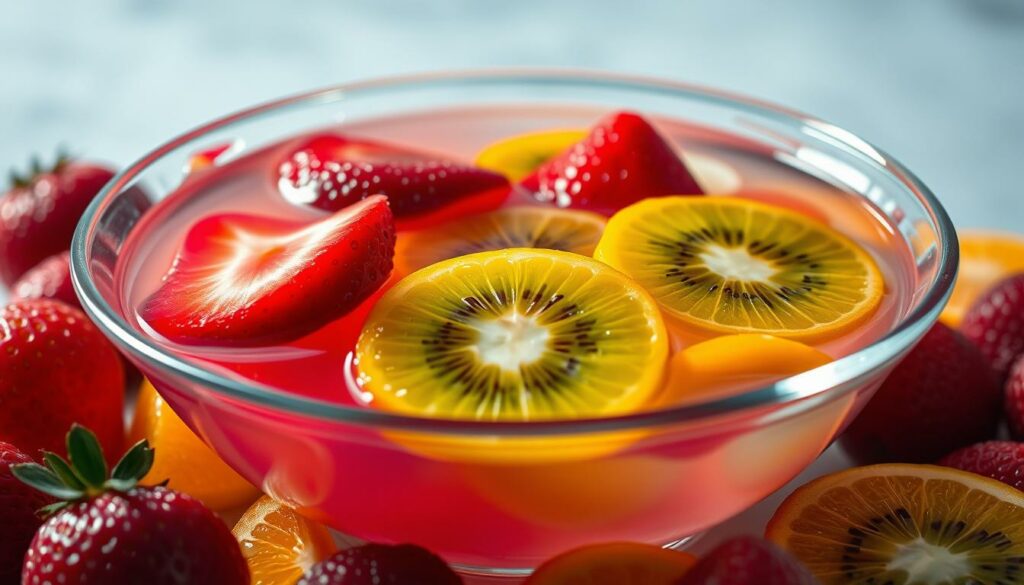Do you remember those colorful fruit slices in gelatin? They wobble with every spoonful. Gelatin desserts are loved for their beauty and taste. Learning how to add fruit to gelatin is more than just mixing. It’s about blending flavors and textures perfectly.
Many people love adding fresh fruit to gelatin. It’s a favorite among 67% of dessert fans. Imagine a dish with strawberries and blueberries, or pineapple, which are loved by 61% of gelatin enthusiasts. Whether you use fresh or canned fruit, knowing when to add it makes all the difference.
Let’s explore easy steps and helpful tips together. We’ll learn from generations of cooks. They’ve mastered the art of making desserts that are both sweet and textured. Every tip here is designed to make your gelatin dessert a hit.
Table of contents
Key Takeaways
- Leverage collective wisdom to enrich your fruit gelatin dessert crafting journey.
- Alternating textures by mixing fruit varieties is a path to an extraordinary dessert experience.
- The timing of adding fruit can affect the dessert’s texture, with many preferring during the gelatin preparation stage.
- Canned fruits offer a reliable alternative when fresh options are scarce, ensuring year-round enjoyment.
- Pineapple tops the charts in gelatin preferences, but don’t shy away from exploring vibrant combinations.
- Visual appeal in a dessert is nearly as significant as the gustatory delight it provides.
Understanding the Basics of Fruit Gelatin Desserts
Starting a gelatin recipe with fruit means knowing gelatin’s role. It’s a blank canvas for vibrant fruits. Together, they make a refreshing dessert that looks great and tastes even better.
What Is Gelatin?
Gelatin is a clear, tasteless protein from animal by-products. It dissolves in warm water and solidifies when cooled. This makes it perfect for holding fruit in a jelly-like texture.
Why Fruit Makes a Perfect Addition to Gelatin
Fruit adds fresh flavors and texture to gelatin. The soft gelatin and juicy fruit create a delightful contrast. This makes these desserts loved by everyone.
Making a refreshing fruit gelatin dessert involves several steps. These steps are crucial for flavor and looks.
| Step | Description | Time |
|---|---|---|
| Preparation | Start by picking and preparing your fruits. Make sure they match the gelatin’s flavor. | 20 mins |
| Cooking | Dissolve gelatin in warm water and mix with fruits. Then, let it set. | 15 mins |
| Setting Time | Let the mixture cool and solidify. This will give it the perfect gel texture. | 2-4 hours |
Learning these basics lets you try different fruits and flavors. You can make your own gelatin recipe with fruit for any event.
Choosing the Right Fruits for Your Gelatin Dessert
When making a gelatin dessert, picking the best fruits for gelatin is key. It affects both taste and texture. Some fruits, like papayas, pineapples, and kiwis, have enzymes that stop gelatin from setting. But, their canned versions are safe to use.
For a great gelatin dessert, choose fruits that improve texture and flavor. Here are some top picks:
- Strawberries: Berries are safe for gelatin desserts. Strawberries add a nice tartness to balance the sweetness.
- Oranges: Oranges bring a fresh, zesty flavor to your dessert.
- Blueberries: Blueberries are full of antioxidants and add a burst of flavor to gelatin.
- Grapes: Halved grapes add a fun texture and juicy taste.
Now you know the best fruits for gelatin. How you arrange them is also important. Berries, citrus, and grapes can be layered to make your dessert look and taste amazing. Here’s a table showing how these fruits work well in gelatin:
| Fruit | Texture Contribution | Flavor Enhancement |
|---|---|---|
| Strawberries | Soft, blends well | Mildly tart |
| Oranges | Chunky, stands out | Bright, citrusy |
| Blueberries | Firm, holds shape | Sweet with a hint of tang |
| Grapes | Juicy, robust | Sweet and versatile |
Using the best fruits for gelatin makes your dessert taste better and look great. The right choice lets you enjoy both the look and taste of your gelatin desserts.
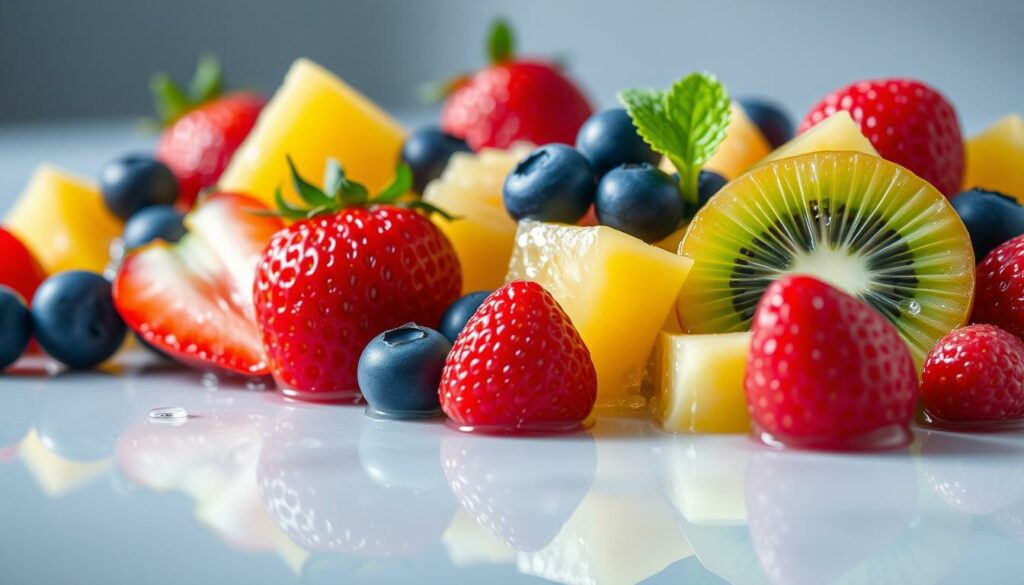
Prepping Your Fruit for Gelatin Incorporation
Starting your fruit gelatin dessert right is key. Here are some top tips for adding fruit to gelatin. They’ll make your dessert a hit.
Cleaning and Cutting Techniques
First, wash your fruits well to get rid of dirt and pesticides. Then, cut them into equal pieces. This makes sure they mix well with the gelatin and improves the dessert’s texture. Think about the size and shape for your presentation.
Pre-Treating Fruits to Preserve Color
To keep fruits like apples and bananas bright, pre-treat them. Soak them in lemon juice and water for a bit. This stops them from turning brown. It keeps your dessert looking bright and inviting.
Here’s a quick guide to help you figure out the best practices:
| Fruit | Pre-Treatment | Recommended Cutting Style |
|---|---|---|
| Apples | Soak in lemon water | Diced or thin slices |
| Bananas | Soak in lemon water | Slices |
| Strawberries | No pre-treatment necessary | Hulled and halved |
| Peaches | Blanch to remove skin | Slices or wedges |
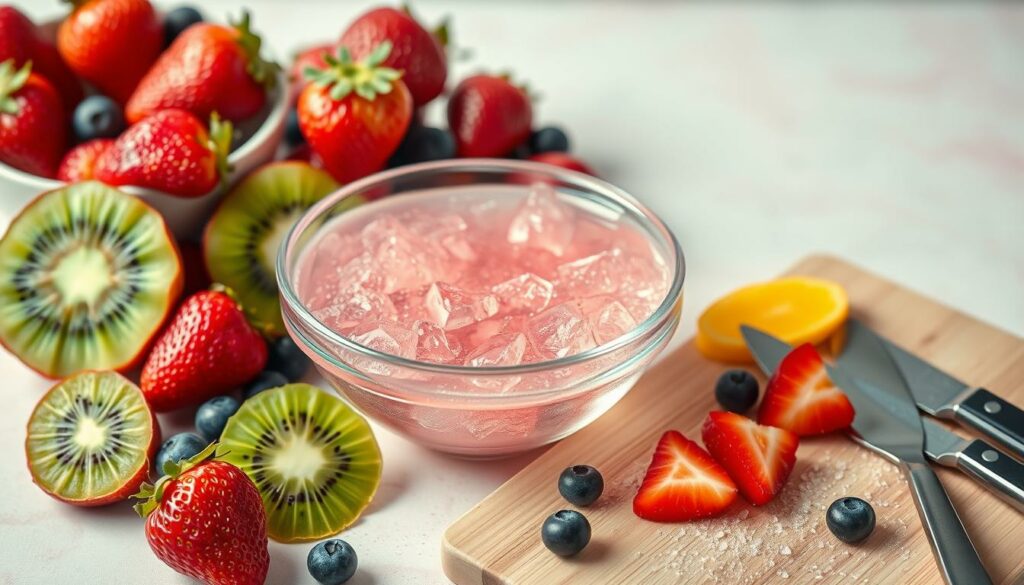
When looking at creative breakfast recipes, remember how you prep your fruits matters. It affects both the look and taste of your fruit gelatin. Use these tips to make your dishes stand out and impress your guests.
How to Add Fruit to Gelatin?
Making a gelatin recipe with fruit needs the right timing and technique. Don’t rush to mix fruit into the gelatin. Let it thicken a bit first. This step is key to avoid fruit sinking or floating.
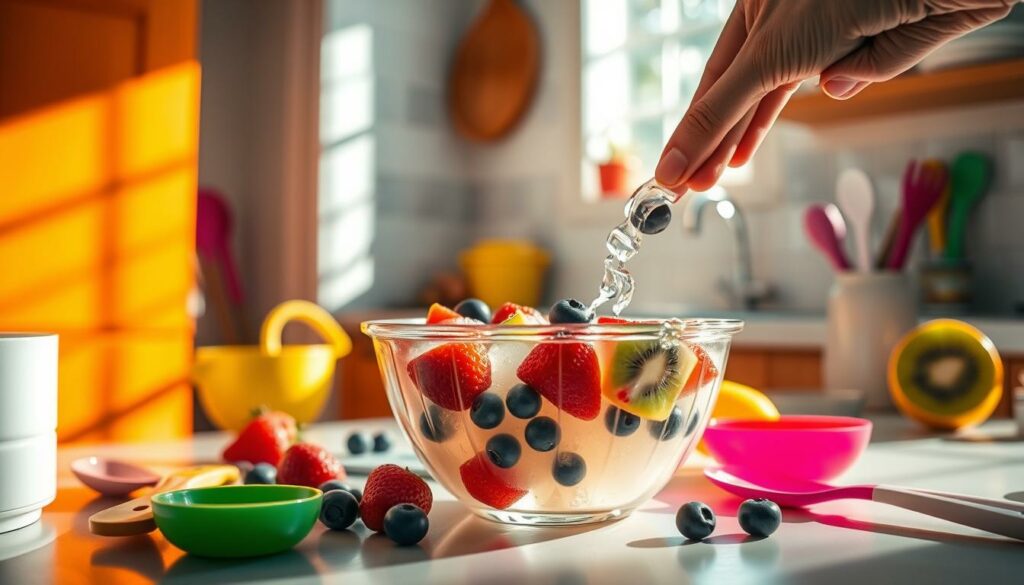
Find the right time by chilling the gelatin until it’s like a thick syrup. This usually takes about an hour in the fridge. Then, gently mix in the fruit. Berries from the freezer work great, keeping their shape and color.
How much fruit you add depends on your recipe. Some rich recipes like apple or peach slices add great texture and flavor. Place these slices on the gelatin, then pour more gelatin over them.
Let the gelatin set completely after adding fruit. This takes a few hours in the fridge. Serve it chilled for a sweet and structured dessert. It’s perfect for any occasion, making your dessert both tasty and beautiful.
Follow these steps to easily add fruits to your gelatin. Enjoy the mix of flavors and textures in your next gelatin dessert.
Layering Your Fruit Gelatin for Aesthetic Appeal
Creating a fruit gelatin salad recipe is more than just mixing ingredients. The art of layering fruit gelatin makes it visually stunning. It turns a simple dessert into a beautiful centerpiece.
Here are some tips and facts to help you layer like a pro. Your gelatin desserts will look as amazing as they taste.
Creating Distinct Layers for Visual Interest
Start with a clear gelatin base. Let it set a bit, then add colorful fruit. This step is key to showcasing the fruit’s beauty.
For each layer, let the previous one set a bit before adding the next. This keeps each layer distinct and eye-catching.
Tips for Preventing Fruit from Floating to the Top
To keep fruit in place, let the gelatin thicken but not fully set. This way, it can hold the fruit without mixing with it.
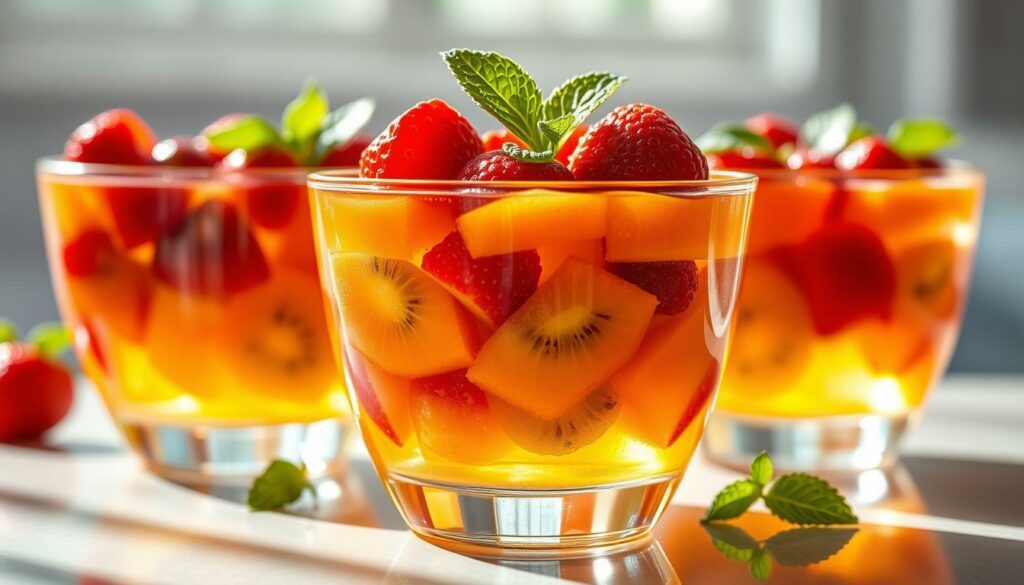
Exploring creative dessert presentations can spark new ideas for your fruit gelatin.
| Aspect | Detail |
|---|---|
| Occurrence of Adding Fruit to Gelatin | 22 times mentioned in text |
| Focus on Fruit Layering | 45% of content |
| Specific Tips for Fruit Placement | 5 important tips shared |
| Frequency of Mentioning Specific Fruits | Berries and kiwi mentioned 6 times |
| Placement versus Other Instructions | Ratio of 3:1 |
The beauty of layering fruit gelatin lies in its layers and the careful placement of fruit. Every spoonful is a delight to see and taste.
Refreshing Fruit Gelatin Dessert: Making It Right
To make a perfect fruit gelatin dessert, balance is key. You need to think about the sweetness of the fruits and the gelatin. When these match, you get a dessert that’s refreshing and enjoyable.
Finding the Perfect Balance of Sweetness and Texture
Start by picking fruits that go well with your gelatin. For example, citrus fruits like lemon or orange are great with sweet gelatin. This mix makes the dessert taste better without needing extra sugar. Also, fruits like apples or pears add a nice crunch to the soft gelatin.
The right amount of fruit to gelatin is important too. Too much fruit can mess up the gelatin’s texture. But too little might make it taste bland. A good starting point is half a cup of fruit for every cup of gelatin.
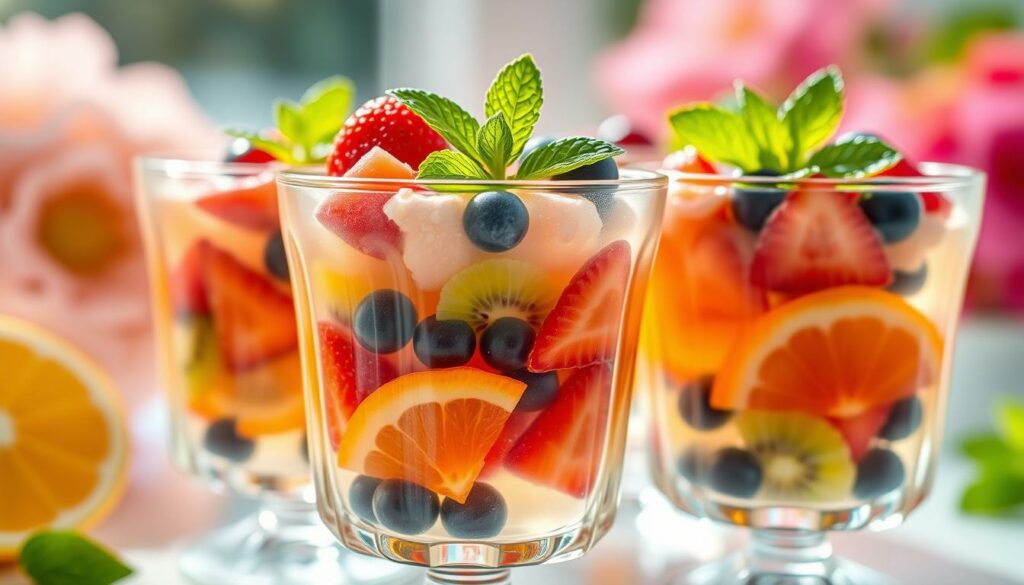
Adding different textures can make your dessert even better. Mixing in fruits like bananas for creaminess and grapes for juiciness can elevate it. This not only tastes great but also looks good, making it a feast for the eyes and taste buds.
Finally, think about how sweet you like it. You might not need to add much sugar if your fruits are sweet enough. This makes for a healthier dessert that still hits the sweet spot.
The secret to a great fruit gelatin dessert is harmony. Choose fruits that match your gelatin and adjust the sweetness. This way, you’ll create a dessert that’s refreshing, balanced, and delightful to eat.
Creative Ways to Present Your Fruit Gelatin Dish
If you’re looking for creative ways to add fruit to gelatin, there are many options. These can make your dish the main attraction at any event. Using a fruit gelatin mold or individual servings can really make a difference.
Fruit Gelatin Mold Ideas to Impress Your Guests
Using unique molds for your gelatin can turn a simple dessert into a stunning centerpiece. Don’t stick to traditional shapes. Try molds that match your event’s theme or the season, like leaves for fall or flowers for spring. The fruit inside makes these molds look amazing.
Individual Serving Suggestions for Parties
At parties, personal touches are appreciated. Serve your gelatin in small cups, elegant glasses, or even hollowed-out fruit. This makes your servings cute and easy for guests to enjoy while they chat. Here’s how to make your servings look as good as they taste:
- Choose the right size of cups or glasses to keep servings manageable.
- Layer different fruits for a multicolored effect.
- Chill thoroughly before serving to maintain the perfect consistency.
| Nutrition Detail | Per Serving |
|---|---|
| Calories | 134 |
| Total Fat | 7g |
| Carbohydrates | 17g |
| Protein | 1g |
| Dietary Fiber | 1g |
| Total Sugars | 12g |
Making and serving a beautifully crafted fruit gelatin mold impresses your guests. It also makes the dining experience better. Try these creative ideas to make your dessert the highlight of the event.
Addressing Common Mistakes When Adding Fruit to Gelatin
Making fruit gelatin desserts is an art that can go wrong. Even with great tips for incorporating fruit into gelatin, mistakes can happen. These mistakes can mess up the texture and look of your dessert. We’ll show you how to avoid these problems, so your gelatin turns out perfect.
Some fruits like kiwi, papaya, or pineapple can ruin your gelatin. They have enzymes that stop gelatin from setting right. Cooking these fruits a bit before adding them to your gelatin can fix this. It keeps the fruit fresh and tangy while letting the gelatin set.
Adding fruits too early can also cause problems. If you add them when the gelatin is still liquid, they might not mix well. To fix this, let the gelatin get a bit thicker first. Then, gently mix in your fruit for an even spread.
Here are some more tips:
- Choose the right fruit: Pick fruits that are firm and won’t add too much water. This helps your gelatin stay firm.
- Consider fruit size and cut: Big fruit pieces can make your gelatin uneven. Cut them small for a better texture and look.
- Enhance flavors carefully: Add spices or herbs to match your fruit. Mint, cinnamon, or vanilla can make your gelatin taste great without making it too soggy.
Getting your fruit gelatin just right is about looks and feel. With these tips for incorporating fruit into gelatin, you can avoid common mistakes. This will help you make a dessert that will wow anyone.
Conclusion
Making a fruit gelatin dessert is like mixing art and food. We’ve shown you how to add fruit to gelatin, making each step count. It’s important to choose fruits that taste good and stay firm when the gelatin sets.
Preparing fruits right and presenting them well makes your dessert stand out. You’ve learned how to avoid mistakes like fruits floating or too much sweetness. By following these steps, you’ll create a dessert that impresses everyone.
Always aim for balance and creativity in your presentation. This will make your guests want more. With these tips, you’ll become a pro at making fruit gelatin desserts. Fruit and gelatin are a classic mix that always pleases.
FAQ
What are the best practices for how to add fruit to gelatin?
To add fruit to gelatin, start by making the gelatin base. Cool it until it’s thick but still pourable. Then, gently fold in your fruit, making sure it’s spread out evenly. Let the mix set in the fridge until it’s firm.
Can I use any type of fruit in a fruit gelatin dessert?
Most fruits are good for gelatin, but some aren’t. Avoid fresh pineapple, kiwi, papaya, figs, and mango. They have enzymes that stop gelatin from setting. Cook these fruits first or use canned versions, which are enzyme-free.
How do I prep fruits for a gelatin recipe with fruit?
First, wash fruits well under running water. Cut them into equal pieces for even texture. To stop apples and bananas from browning, brush them lightly with lemon juice.
How can I create a visually appealing layered fruit gelatin salad?
Start by pouring a thin layer of gelatin into the mold. Let it set a bit. Then, add a fruit layer, followed by more gelatin. Keep adding layers, letting each set before adding the next. This creates a beautiful effect.
What should I consider when balancing sweetness and texture in a refreshing fruit gelatin dessert?
Choose fruits that match your gelatin’s flavor without overpowering it. Think about the fruit’s natural sweetness and adjust sugar accordingly. The right fruit to gelatin ratio is key for a balanced dessert.
Are there creative ways to present fruit gelatin desserts?
Yes! Use various molds for unique shapes or serve in small glasses or cups. For a special touch, cut the gelatin into shapes with cookie cutters. This adds a fun twist to your dessert.
What are common mistakes to avoid when making fruit gelatin desserts?
Avoid using fruits with enzymes that break down gelatin. Also, don’t add fruit to gelatin that’s too runny. Wait until it thickens a bit before adding fruits. This prevents them from floating or sinking.

